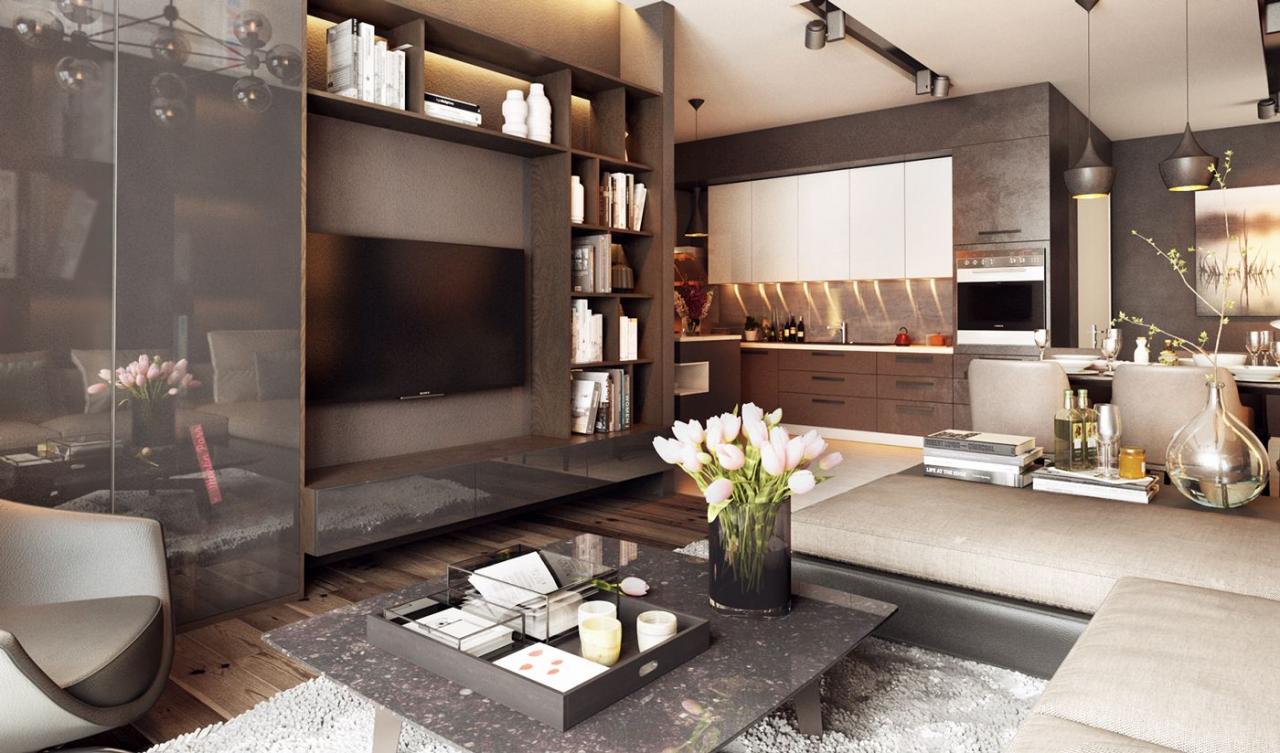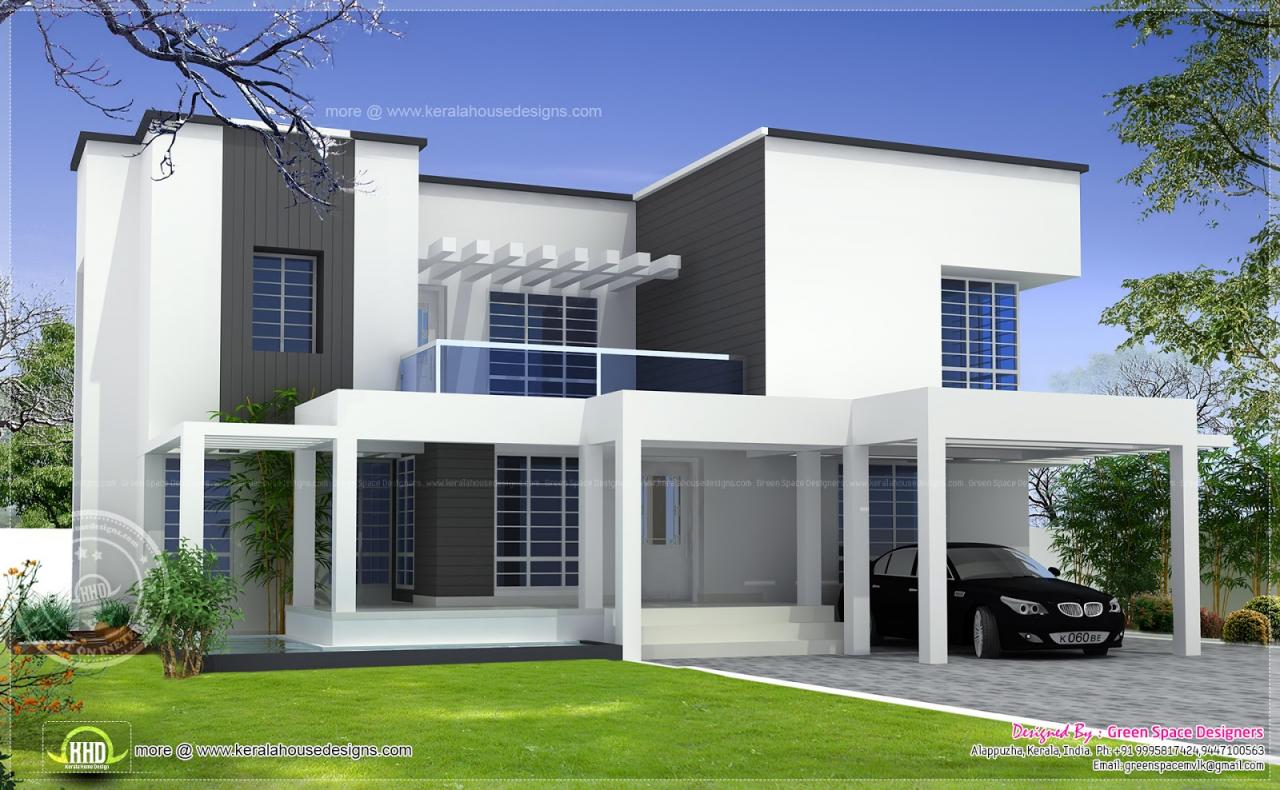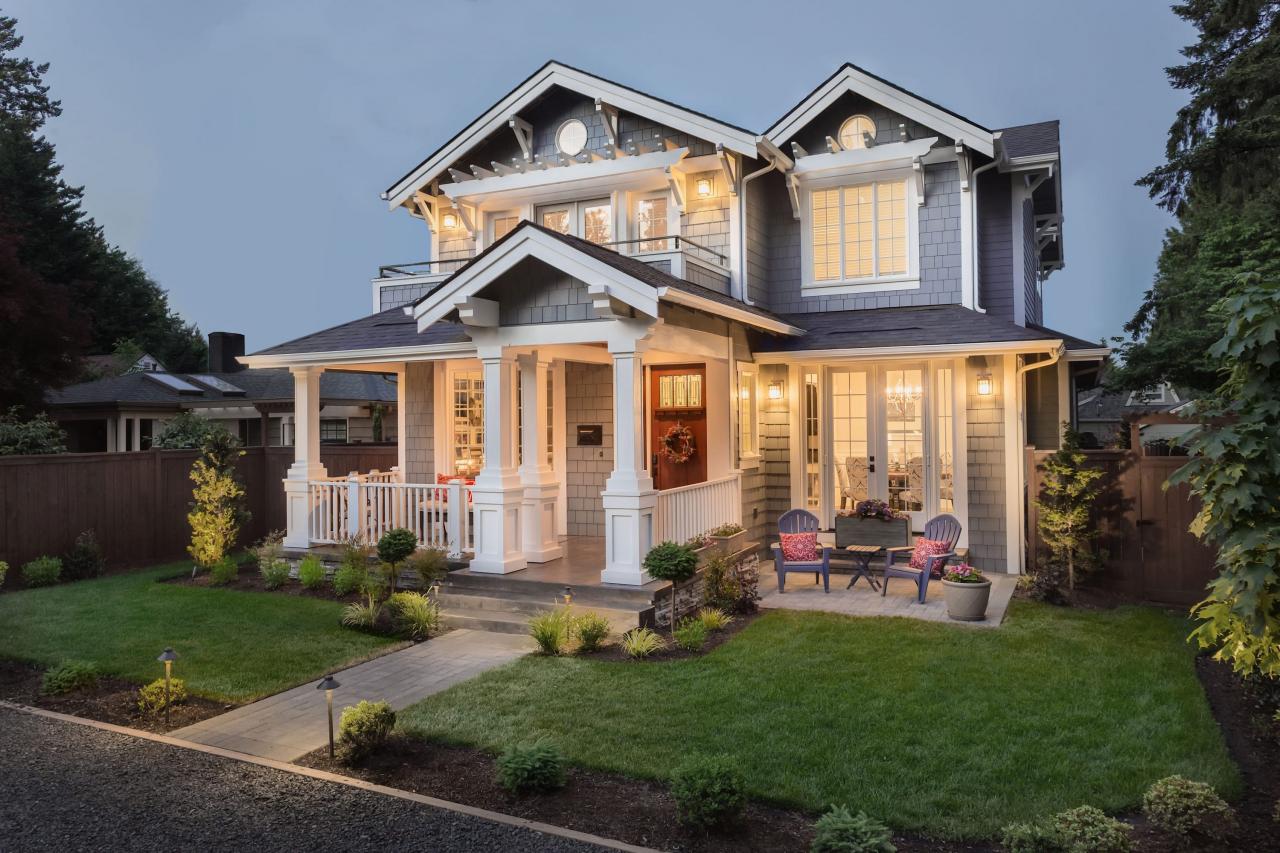Classic modern home design incorporating smart home technology is more than just a trend; it’s a revolution in how we live. Imagine a home where sleek, minimalist aesthetics seamlessly blend with cutting-edge technology, creating a space that’s both beautiful and effortlessly functional. This isn’t about sacrificing style for convenience—it’s about elevating both to new heights. We’ll explore how to achieve this harmonious balance, from selecting the right smart home platform to discreetly integrating devices that enhance, not detract, from your classic modern aesthetic.
This exploration delves into the key elements of classic modern architecture—clean lines, natural materials, and a neutral color palette—and shows how smart technology can complement these features without disrupting the overall ambiance. We’ll cover everything from smart lighting and climate control to integrated appliances and entertainment systems, offering practical advice and inspiring examples to help you create the smart home of your dreams.
Defining Classic Modern Home Design: Classic Modern Home Design Incorporating Smart Home Technology

Classic modern home design, a timeless architectural style, seamlessly blends clean lines and functional spaces with a touch of understated elegance. It’s a style that prioritizes simplicity and sophistication, rejecting unnecessary ornamentation while embracing high-quality materials and craftsmanship. This enduring aesthetic continues to inspire contemporary architects and homeowners alike.
Key Architectural Features of Classic Modern Homes
Classic modern homes are characterized by their straightforward, geometric forms. Think simple, rectangular shapes, flat roofs, and open floor plans that maximize natural light and create a sense of spaciousness. Large windows, often floor-to-ceiling, are a defining feature, blurring the lines between indoors and outdoors. Minimalist detailing, clean lines, and a focus on functionality are paramount. Often, these homes feature cantilevered elements, creating a sense of lightness and visual interest.
The overall effect is one of refined simplicity and sophisticated minimalism.
Typical Materials Used in Classic Modern Home Construction
The materials used in classic modern homes reflect a commitment to both durability and aesthetic appeal. Concrete, steel, and glass are frequently employed for their clean lines and modern aesthetic. Natural materials like wood and stone are also incorporated, often used as accents to complement the more industrial elements. The choice of materials often emphasizes texture and the interplay of light and shadow.
For example, exposed concrete walls might be contrasted with warm wood flooring, creating a balanced and sophisticated effect.
Color Palettes Commonly Associated with Classic Modern Design
Classic modern design favors a restrained and neutral color palette. Whites, grays, and blacks are frequently used as a base, providing a clean and uncluttered backdrop. Accents of bolder colors, such as deep blues, greens, or even pops of vibrant yellow, are sometimes introduced sparingly to add visual interest and warmth. The overall effect is one of sophisticated simplicity, where the focus remains on the architecture and the interplay of light and shadow.
Earthy tones are also frequently incorporated, bringing a natural element into the design.
Examples of Iconic Classic Modern Homes and Their Defining Characteristics, Classic modern home design incorporating smart home technology
The Case Study Houses program in post-war California produced several iconic examples of classic modern architecture. Houses like the Eames House, designed by Charles and Ray Eames, exemplify the style’s focus on functionality and innovative materials. Its open plan, steel frame, and expansive glass walls showcase the integration of indoor and outdoor living. Similarly, the Stahl House, also known as the Case Study House #22, perched dramatically on a hillside, showcases the use of steel and glass to create a stunning and minimalist dwelling.
Its dramatic setting and expansive views further highlight the connection between architecture and landscape, a key element of classic modern design. These homes serve as enduring testaments to the enduring appeal of classic modern architecture.
Classic modern homes are all about sleek lines and efficient space, and incorporating smart home technology enhances this aesthetic. For those with smaller lots, maximizing space is key, which is why checking out ideas like those found in this guide on classic modern home design ideas for small lots is super helpful. These design principles, combined with smart lighting, thermostats, and security systems, create a stylish and technologically advanced living experience, even in a compact footprint.
Integrating Smart Home Technology

A classic modern home, with its emphasis on clean lines, minimalist aesthetics, and high-quality materials, presents a unique opportunity to seamlessly integrate smart home technology. The goal isn’t to overwhelm the design but to enhance its functionality and convenience, creating a truly luxurious and effortless living experience. Smart technology should subtly enhance the home’s elegance, not detract from it.Smart home systems in a classic modern house should prioritize seamless integration, meaning the technology should blend effortlessly with the architecture and décor.
This requires careful planning and selection of devices that prioritize form as much as function. Think sleek, minimalist designs that complement the clean lines of the home, avoiding bulky or visually jarring elements. A well-integrated system operates almost invisibly, enhancing the home’s functionality without compromising its aesthetic appeal.
Smart Home System Design for Classic Modern Homes
A smart home system for a classic modern residence should focus on key areas to maximize both functionality and aesthetic appeal. Lighting control is paramount; imagine a system that allows for customizable lighting scenes, from bright and airy daytime settings to warm and inviting evening ambiances, all controlled via a centralized app or voice commands. Climate control is another crucial aspect; a smart thermostat can learn your preferences and automatically adjust temperatures for optimal comfort and energy efficiency.
Security is also vital; a smart security system with integrated cameras, door sensors, and motion detectors can provide peace of mind, with discreetly placed devices that don’t clash with the home’s design. Finally, consider integrating smart speakers for voice control of various functions, adding a layer of effortless convenience. All systems should ideally be interconnected and controllable through a single, user-friendly interface.
Benefits of Smart Home Technology in Classic Modern Homes
The incorporation of smart home technology offers significant benefits in a classic modern home. Enhanced convenience is a key advantage; imagine controlling lights, temperature, and entertainment systems with a simple voice command or a tap on your smartphone. Improved energy efficiency is another significant benefit; smart thermostats and lighting systems can learn your usage patterns and optimize energy consumption, leading to lower utility bills and a smaller environmental footprint.
Increased security is also a substantial advantage; a comprehensive smart security system can significantly deter intruders and provide real-time alerts, enhancing safety and peace of mind. Finally, increased home value is a noteworthy benefit; smart homes are increasingly sought after, making them a desirable investment.
Comparison of Smart Home Platforms
Several smart home platforms are available, each with strengths and weaknesses regarding aesthetic integration into a classic modern home. Consider platforms like Control4, Crestron, or Savant, which are known for their high-end aesthetics and seamless integration capabilities. These systems often offer customizability, allowing for tailored interfaces and device selections to perfectly match the home’s style. Alternatively, more affordable platforms like Apple HomeKit or Google Home might be considered, although they may require more careful device selection to maintain a cohesive and minimalist aesthetic.
The choice depends on budget, desired level of customization, and technical expertise.
Challenges of Integrating Smart Home Technology in Historically Styled Homes
While seamlessly integrating smart technology into a classic modern home is generally straightforward, some challenges may arise. Maintaining the home’s original aesthetic is crucial; the installation of smart devices should be discreet and avoid disrupting the clean lines and minimalist design. Wiring and infrastructure limitations might also present challenges; older homes may require upgrades to accommodate the demands of a comprehensive smart home system.
Furthermore, ensuring compatibility between different smart devices and platforms is vital for a cohesive and functional system. Careful planning and professional installation are essential to overcome these challenges and ensure a successful integration.
Smart Home Features for Enhanced Living

Integrating smart technology seamlessly into a classic modern home elevates the living experience beyond mere convenience. It transforms the space into a responsive, efficient, and secure environment tailored to the homeowner’s needs and preferences. This section explores essential smart features that enhance security, comfort, and overall functionality within a classic modern design.
Smart Home Security Features
A classic modern home, with its often expansive windows and minimalist design, benefits significantly from a robust smart security system. The following table Artikels key features and their integration into a classic modern aesthetic:
| Feature | Benefit | Integration | Cost |
|---|---|---|---|
| Smart Security System (with cameras and sensors) | Real-time monitoring, intrusion detection, remote access, and automated alerts. | Discreetly placed cameras blend with the architecture; sensors can be integrated into door frames and window casings. | $500 – $3000+ (depending on system complexity and features) |
| Smart Locks | Keyless entry, remote locking/unlocking, and access codes for guests. | Sleek, minimalist designs available to complement modern aesthetics. | $150 – $400+ per lock |
| Smart Lighting | Deterrent to potential intruders through automated lighting schedules simulating occupancy. | Recessed lighting and strategically placed outdoor fixtures can be automated. | Varies greatly depending on the number of lights and system complexity. |
| Smart Smoke and Carbon Monoxide Detectors | Early warning system for fire and carbon monoxide leaks, with remote monitoring and alerts. | Discreetly integrated into the ceiling or walls. | $50 – $200+ per detector |
Smart Lighting and Climate Control
Smart lighting and climate control systems are transformative in a classic modern home. Smart lighting allows for precise control of ambiance, enhancing the mood and functionality of each space. For example, dimming lights in the living room for a relaxing evening or setting a vibrant scene for a dinner party is effortlessly achieved. The integration of smart bulbs with voice assistants allows for hands-free operation, aligning perfectly with the streamlined aesthetic of a modern home.
Similarly, smart climate control systems offer precise temperature regulation, energy efficiency, and remote control. Imagine pre-heating your home before arriving on a cold winter evening, or adjusting the temperature remotely to conserve energy while away. This level of control significantly enhances comfort and contributes to energy savings.
Smart Appliances in the Classic Modern Kitchen
Smart appliances seamlessly integrate into the streamlined functionality of a classic modern kitchen. Smart refrigerators can track inventory, suggest recipes based on available ingredients, and even order groceries automatically. Smart ovens and cooktops offer precise temperature control, pre-programmed cooking settings, and remote monitoring, ensuring perfectly cooked meals every time. Smart dishwashers optimize cleaning cycles based on load size and soil level, saving water and energy.
Classic modern home design, incorporating smart home technology, offers unparalleled convenience and style. The seamless integration of automation enhances the already impressive aesthetic of these homes, and this is especially true when you consider the spaciousness often found in a classic modern home design with open floor plan. This open layout allows smart devices to control and connect various areas effortlessly, maximizing the benefits of your smart home setup.
Ultimately, combining smart technology with a classic modern design creates a truly luxurious and future-proof living space.
The integration of these appliances not only enhances efficiency but also streamlines the cooking and cleaning process, making the kitchen a more enjoyable and less stressful space. For example, a smart oven’s notification system ensures that the homeowner never overcooks a meal.
Smart Home Entertainment System
A well-designed smart home entertainment system complements the classic modern aesthetic. A sleek, wall-mounted television, perhaps integrated into a custom media cabinet, provides a focal point without compromising the clean lines of the design. For audio, consider a multi-room sound system with discreetly placed speakers. In-ceiling speakers can be seamlessly integrated, while bookshelf speakers can be selected to complement the home’s existing furniture.
The system should be controllable via voice assistants or a central app, allowing for effortless selection of music, movies, and other media. The integration of smart lighting with the entertainment system can enhance the viewing experience, creating a truly immersive environment. For example, automatically dimming the lights when a movie starts enhances the cinematic effect.
Aesthetics and Functionality
Blending cutting-edge technology with the timeless elegance of classic modern design requires careful consideration. The goal isn’t to showcase the tech, but to seamlessly integrate it, enhancing both the home’s appearance and its functionality. This delicate balance demands a strategic approach, ensuring smart devices complement, rather than clash with, the overall aesthetic.Smart home integration in a classic modern home presents unique challenges.
The clean lines, minimalist aesthetic, and often neutral color palettes of classic modern design can be disrupted by bulky devices or obtrusive wiring. However, with thoughtful planning and the right choices, these conflicts can be easily resolved, resulting in a home that is both technologically advanced and visually stunning.
Maintaining Classic Modern Aesthetics with Discreet Smart Home Technology
The key to successful integration lies in choosing devices that are aesthetically compatible. Think sleek, minimalist designs in neutral colors that blend seamlessly into the existing décor. Recessed lighting with smart bulbs is a perfect example—offering intelligent control without compromising the clean lines of the ceiling. Similarly, smart speakers can be integrated into existing shelving or hidden within custom cabinetry, maintaining a clutter-free environment.
Consider using smart thermostats that are designed to blend into the wall, rather than standing out as a separate unit. The focus should always be on functionality that’s invisible or subtly integrated into the design.
Addressing Potential Design Conflicts Between Smart Home Devices and Classic Modern Design Elements
One potential conflict arises from the visible wiring often associated with smart home installations. However, this can be mitigated through careful planning and professional installation. Concealed wiring within walls and floors is essential, maintaining the clean lines of the classic modern style. Another challenge is the size and appearance of some smart devices. Larger, more obtrusive devices should be carefully placed, perhaps within dedicated media centers or cleverly disguised within built-in units.
For example, a smart security system’s central hub could be housed in a custom-built cabinet, maintaining a streamlined look.
Enhancing the Overall Ambiance of a Classic Modern Home with Smart Home Technology
Smart lighting offers unparalleled control over ambiance. Scene setting allows for pre-programmed lighting configurations tailored to different moods or times of day. Imagine transitioning from bright, crisp daylight illumination to a warm, inviting glow for evening relaxation, all controlled seamlessly through a central system or a smartphone app. Smart speakers can enhance the atmosphere with background music, seamlessly integrated into the home’s sound system.
Automated window shades, responding to natural light and time of day, can further enhance the feeling of comfort and control. The use of subtle, indirect lighting, controlled via smart technology, can add depth and sophistication to the classic modern aesthetic.
Improving Energy Efficiency in a Classic Modern Home with Minimal Visual Impact
Smart thermostats provide significant energy savings by learning user preferences and automatically adjusting temperatures accordingly. Their sleek designs often blend seamlessly into the wall, maintaining the minimalist aesthetic. Smart lighting, with its ability to dim automatically or turn off unoccupied rooms, contributes substantially to energy efficiency. Smart power strips allow for the efficient control of appliances and electronics, preventing energy waste from devices left on standby.
These energy-saving measures, when implemented discreetly, can have a positive impact on both the home’s energy consumption and its visual appeal. For instance, a smart power strip could be discreetly tucked away behind a piece of furniture, effectively managing energy without disrupting the overall design.
Illustrative Examples

Classic modern design, with its emphasis on clean lines, minimalist aesthetics, and functional spaces, provides the perfect canvas for integrating smart home technology seamlessly. The following examples illustrate how smart features can enhance the living experience without compromising the home’s sophisticated style.
Classic Modern Living Room
Imagine a living room bathed in natural light, with large windows framing stunning city views. The space is defined by a neutral color palette – think soft greys and creamy whites – accented by sleek, dark wood furniture. A modular sofa, upholstered in a luxurious fabric, sits facing a minimalist fireplace, its flames dancing in a smart-controlled bio ethanol fire insert.
Recessed LED lighting, controlled via a smart home hub, allows for customizable ambiance. Subtle, strategically placed smart speakers blend seamlessly into the decor, providing high-fidelity audio without visual clutter. A large, ultra-high-definition television, almost invisibly mounted in the wall, disappears when not in use, maintaining the room’s uncluttered aesthetic. Smart sensors detect occupancy and automatically adjust lighting and temperature for optimal comfort.
Classic Modern Kitchen
The kitchen is a hub of activity, and smart technology elevates its functionality. Sleek, handleless cabinetry in matte white lacquer creates a sense of spaciousness. Quartz countertops, with their cool, smooth surfaces, complement the stainless steel appliances. A smart refrigerator displays its contents, generates shopping lists, and even orders groceries when supplies run low. The oven and cooktop are smart-enabled, allowing for preheating and cooking adjustments from a smartphone or tablet.
Integrated smart lighting under the cabinets provides task lighting while accentuating the clean lines of the design. A smart water filter ensures pristine drinking water, and a smart garbage disposal system quietly and efficiently handles waste. The overall effect is one of seamless integration – technology working unobtrusively to enhance the culinary experience.
Classic Modern Bedroom
The bedroom is a sanctuary of peace and relaxation, and smart technology enhances this atmosphere. Soft, natural light filters through sheer curtains, while recessed LED lighting provides adjustable brightness for reading or relaxing. A smart thermostat maintains the ideal temperature throughout the night, ensuring restful sleep. Smart blinds automatically open and close at pre-set times, regulating light and temperature.
A smart alarm clock gently wakes you with natural light and calming sounds, replacing the jarring tones of traditional alarms. Smart speakers can play soothing music or nature sounds, creating a serene environment. The overall design is minimalist and elegant, prioritizing comfort and convenience without sacrificing style. The smart features enhance the feeling of calm and tranquility.